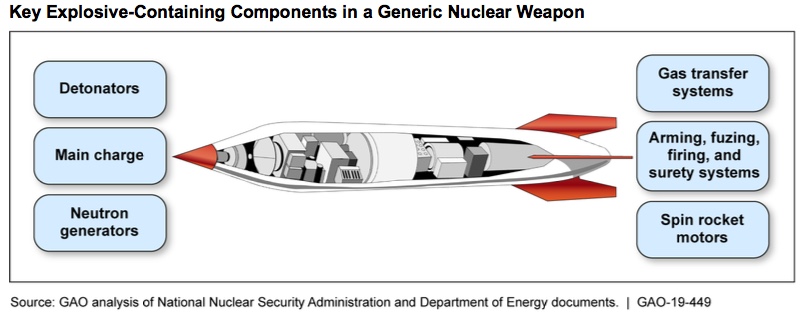
Five National Nuclear Security Administration (NNSA) contractor-operated sites conduct activities to design and produce explosive materials. NNSA officials and contractor representatives identified several challenges related to explosives activities, such as the agency’s dwindling supply of explosive materials, aging and deteriorating infrastructure, and difficulty recruiting and training qualified staff. NNSA issued a plan to address these challenges. But it didn’t follow strategic planning practices that ensure accountability over progress. For example, it generally didn’t include measurable performance goals that identify timeframes and responsible parties.
In June 2019, the Government Accountability Office (GAO) released a report to Congress – Additional Actions Could Help Improve Management of Activities Involving Explosive Materials
A Senate committee report accompanying a bill for the National Defense Authorization Act for Fiscal Year 2018 included a provision for GAO to review NNSA’s high explosive capabilities specific to nuclear weapons. This report examines (1) explosives activities that NNSA and its sites conduct and how NNSA manages these activities; (2) challenges NNSA officials and contractor representatives have identified in conducting explosives activities and the extent to which NNSA has taken actions to address these challenges; and (3) the extent to which NNSA’s strategic plan for explosives activities describes further actions, if any, to address the challenges NNSA officials and contractor representatives have identified and follows leading practices for strategic planning.
Approximately 100 different explosive components are essential to the operation of U.S. nuclear weapons. Explosives serve many functions in nuclear weapons because they can deliver energy quickly and precisely. The Department of Energy (DOE) and its contractors ceased producing some key explosives used in nuclear weapon components in the early 1990s. NNSA and its contractor-operated sites have recently resumed their production and testing of some explosives in support of ongoing life extension programs (LEP) and modernization efforts for nuclear weapons. Many of the facilities that support NNSA’s LEPs and modernization efforts—and the related activities to develop and produce explosives—were built in the 1940s and 1950s, making them costly and difficult to maintain. The age and condition of some of these facilities also pose safety issues if mitigation actions are not implemented, according to NNSA documents. In this context, in December 2018, NNSA released its Defense Programs Strategic Plan for Energetic Materials (strategic plan), which provided a framework for addressing challenges related to managing explosive materials and related activities, such as NNSA’s aging infrastructure, as well as strategies to mitigate them.
GAO analyzed data from the Facilities Information Management System (FIMS), DOE’s official real property database, according to DOE’s order on real property management, on NNSA’s explosives-related real property assets. “Assets” include buildings, trailers, and other facilities and infrastructure, such as power lines. However, NNSA managers may be relying on inaccurate FIMS data on infrastructure related to explosives activities to make modernization decisions, because the GAO found a number of inaccuracies in FIMS data on explosives activities.
NNSA is revising its strategic plan for energetic materials, but it does not contain fully developed elements that GAO has previously reported that effective strategic plans should include, such as a fully developed mission statement and performance goals that are quantifiable, set time frames for completion, and list responsible parties to carry out specific activities. NNSA officials said that they intend to revise the strategic plan in 2020. GAO states that including fully developed elements of an effective strategic plan—such as a fully developed and clearly identified mission statement and performance goals that are quantifiable, have time frames for completion, and list responsible parties to carry out specific activities for all strategic goals— NNSA would help make the strategic plan more useful in measuring goal achievement and assessing accountability.
